| Issue Date | 25.03.2016 |
| ID | Michel: Scott: Stanley Gibbons: Yvert: UPU: Category: pR |
| Designer |
stamp design: Edi Berk photo: Matija Križnar, Ciril Mlinar from Natural History Museum of Slovenia in Ljubljana |
| Stamps in set | 1 |
| Value | €0.58 - Cave bear, Ursus spelaeus |
| Size (width x height) | 42.60 x 29.82 mm |
| Layout | Sheet of 25 stamps |
| Products | FDC x1 |
| Paper | |
| Perforation | 14 x 14 |
| Print Technique | Offset, 4 colours |
| Printed by | Agencija za komercijalnu djelatnost d.o.o., Zagreb,
Croatia |
| Quantity | 500.000 |
| Issuing Authority | Posta Slovenije |
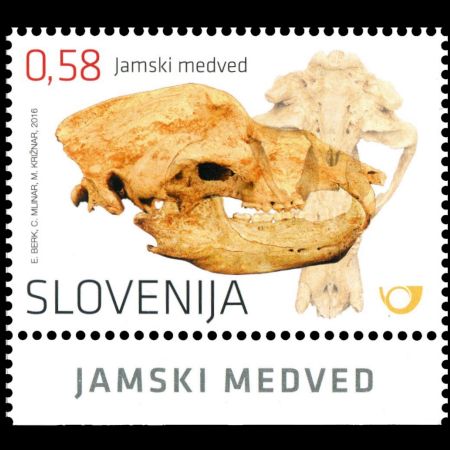
On March 25, Slovenian Post Authority issued a single stamp with fossil of Cave Bear. The cave bear is one of the most typical examples of the Pleistocene megafauna that once roamed the Slovene landscape.
Cave bear remains have been discovered in a large number of sites in Europe and western Asia. The ancestors of the cave bears that inhabited the Ice Age landscape can be traced back more than a million years. The last species of cave bears were omnivorous animals about the size of a cow. There are more than 70 documented cave bear sites in Slovenia. The best known are Potočka Zijalka (a cave on the southern slope of
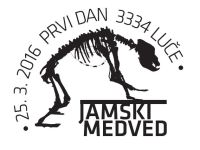 Olševa),
Mokriška Jama (a cave above the valley of the Kamniška
Bistrica), Križna Jama ("Cross Cave") near Lož, and the Divje Babe cave
near
Cerkno. Enormous quantities of bones have been unearthed in the large
number of caves where cave bear remains have been found, indicating the
presence
of up to a thousand animals. Bones found in caves are covered by layers
of
sediment, while in open-air sites (such as quarries) bones are often
discovered
by chance.
Olševa),
Mokriška Jama (a cave above the valley of the Kamniška
Bistrica), Križna Jama ("Cross Cave") near Lož, and the Divje Babe cave
near
Cerkno. Enormous quantities of bones have been unearthed in the large
number of caves where cave bear remains have been found, indicating the
presence
of up to a thousand animals. Bones found in caves are covered by layers
of
sediment, while in open-air sites (such as quarries) bones are often
discovered
by chance. 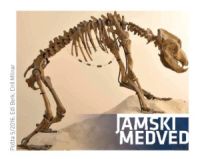 Cave bears used to be known by the scientific name Ursus
spelaeus and it was long believed that this was the only
species to settle in Europe. In the last decade, however, fresh
excavations and genetic
analyses have enabled researchers to prove the existence of a number of
other
species or subspecies of cave bears. These species are distinguished
from each
other both by genetic differences and by the shape of their skulls and
teeth. In
Slovenia today we have thus been able to identify the remains of Ursus
deningeri (Herkova Jama), Ursus ingressus
(Potočka Zijalka
and many other caves) and Ursus ladinicus (Ajdovska
Jama). The last cave
bears in Slovenia died out approximately 25,000 years ago.
Cave bears used to be known by the scientific name Ursus
spelaeus and it was long believed that this was the only
species to settle in Europe. In the last decade, however, fresh
excavations and genetic
analyses have enabled researchers to prove the existence of a number of
other
species or subspecies of cave bears. These species are distinguished
from each
other both by genetic differences and by the shape of their skulls and
teeth. In
Slovenia today we have thus been able to identify the remains of Ursus
deningeri (Herkova Jama), Ursus ingressus
(Potočka Zijalka
and many other caves) and Ursus ladinicus (Ajdovska
Jama). The last cave
bears in Slovenia died out approximately 25,000 years ago.
Matija
Križnar, Department of Geology, Natural History Museum of
Slovenia

| FDC |
|
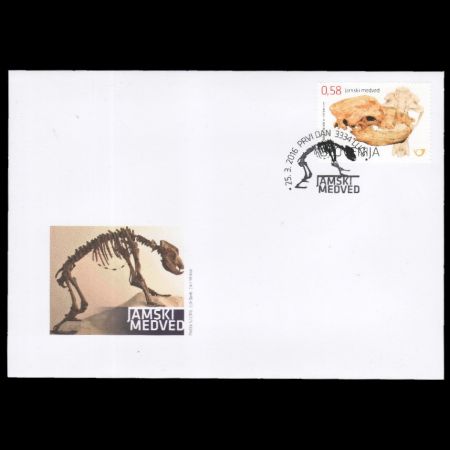 |
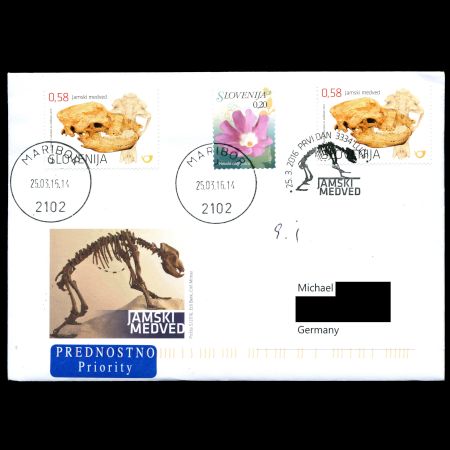
|
| Used covers | |
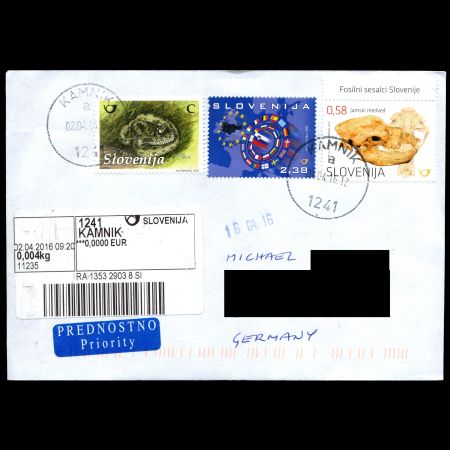 |
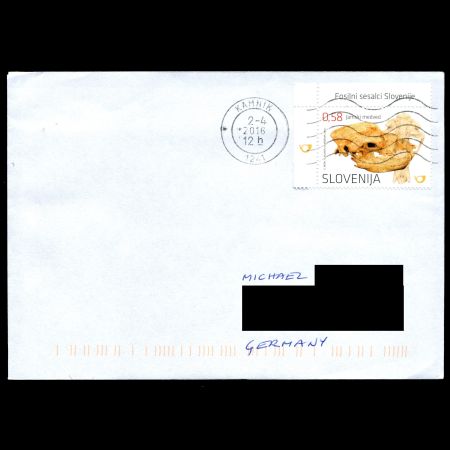 |
References: Press release of Slovenian Post
 |
|
Last update 10.12.2017
Any feedback, comments or even complaints are welcome: [email protected] (you can email me on ENglish, DEutsch, or RUssian)